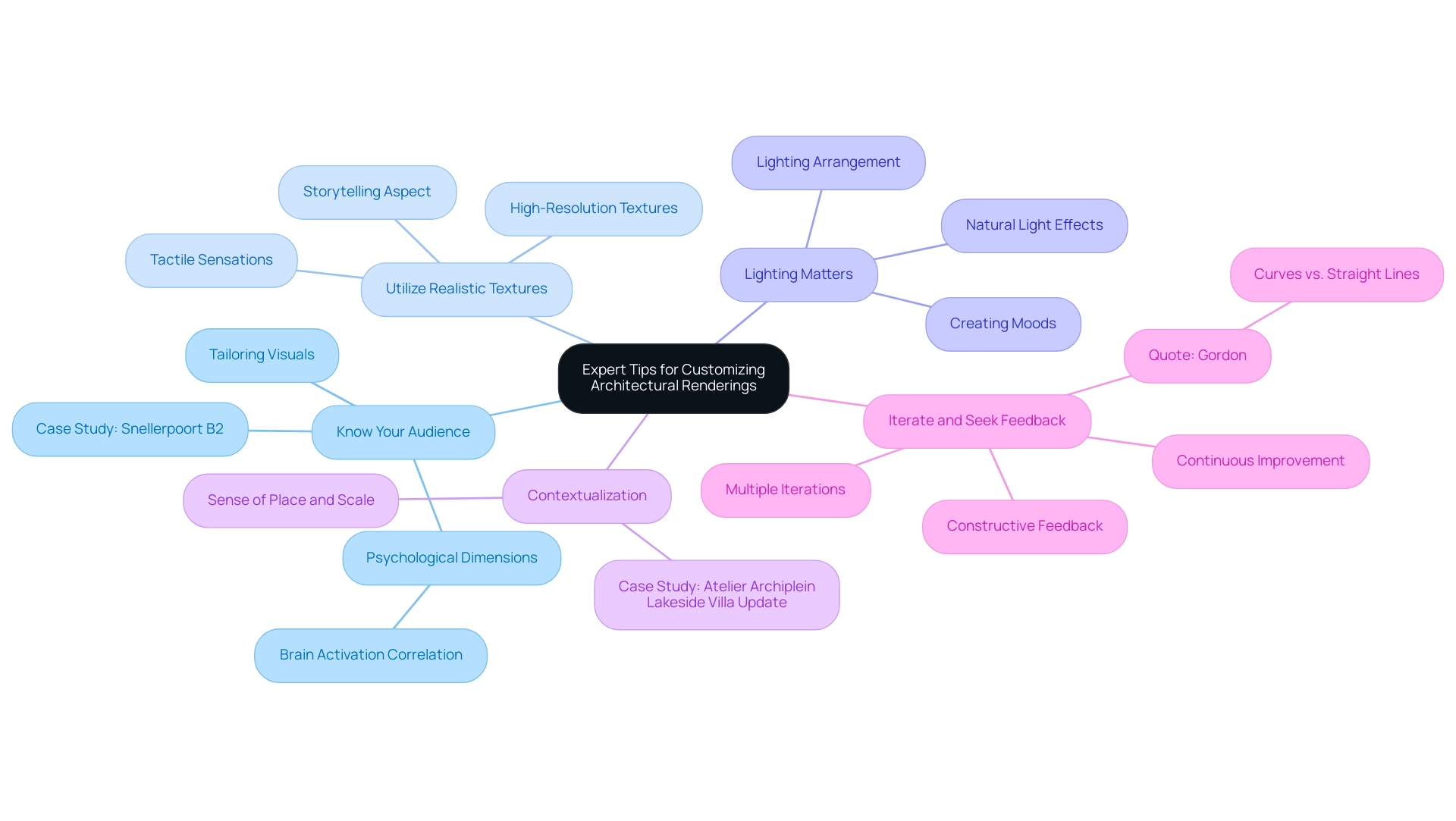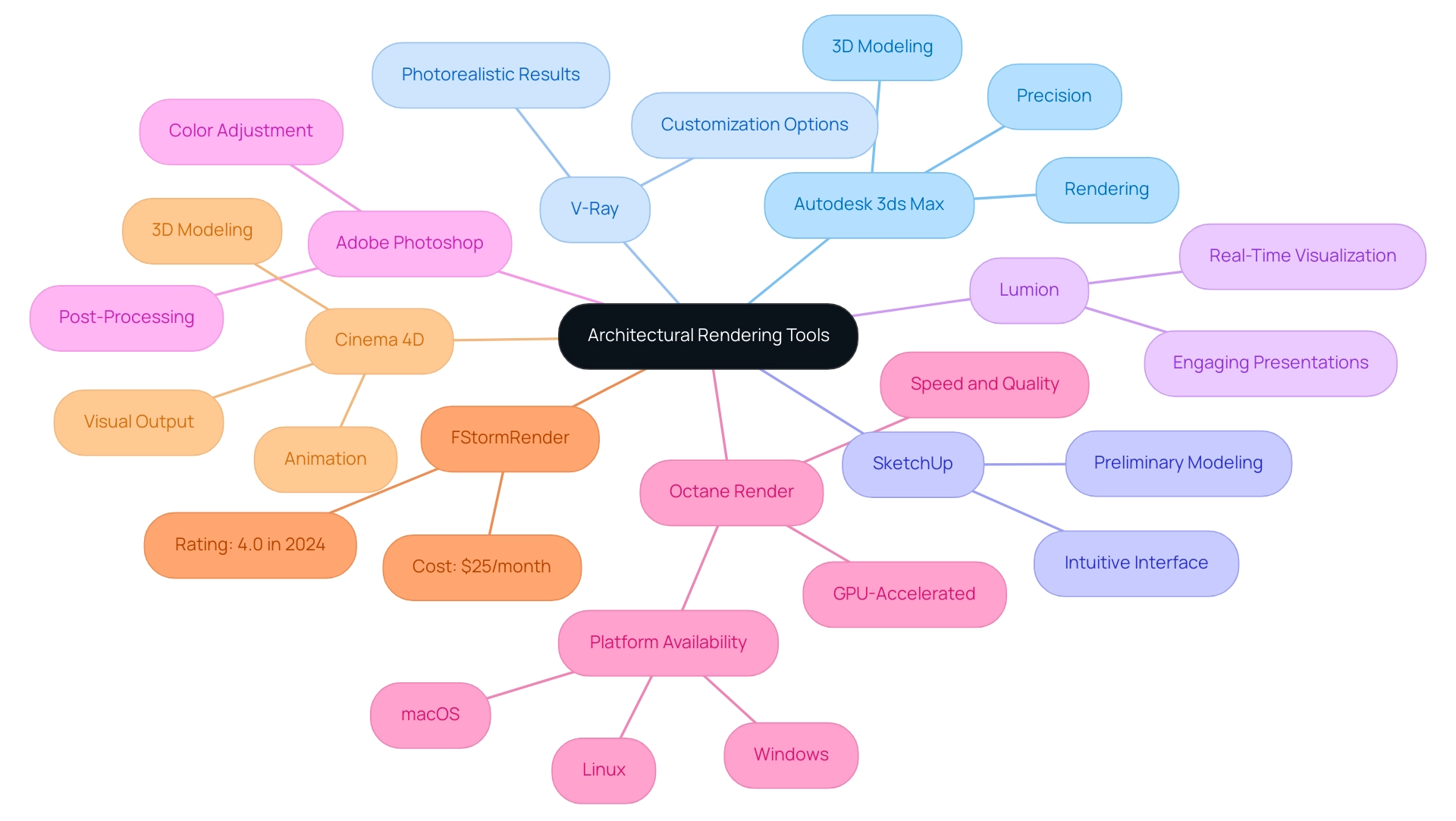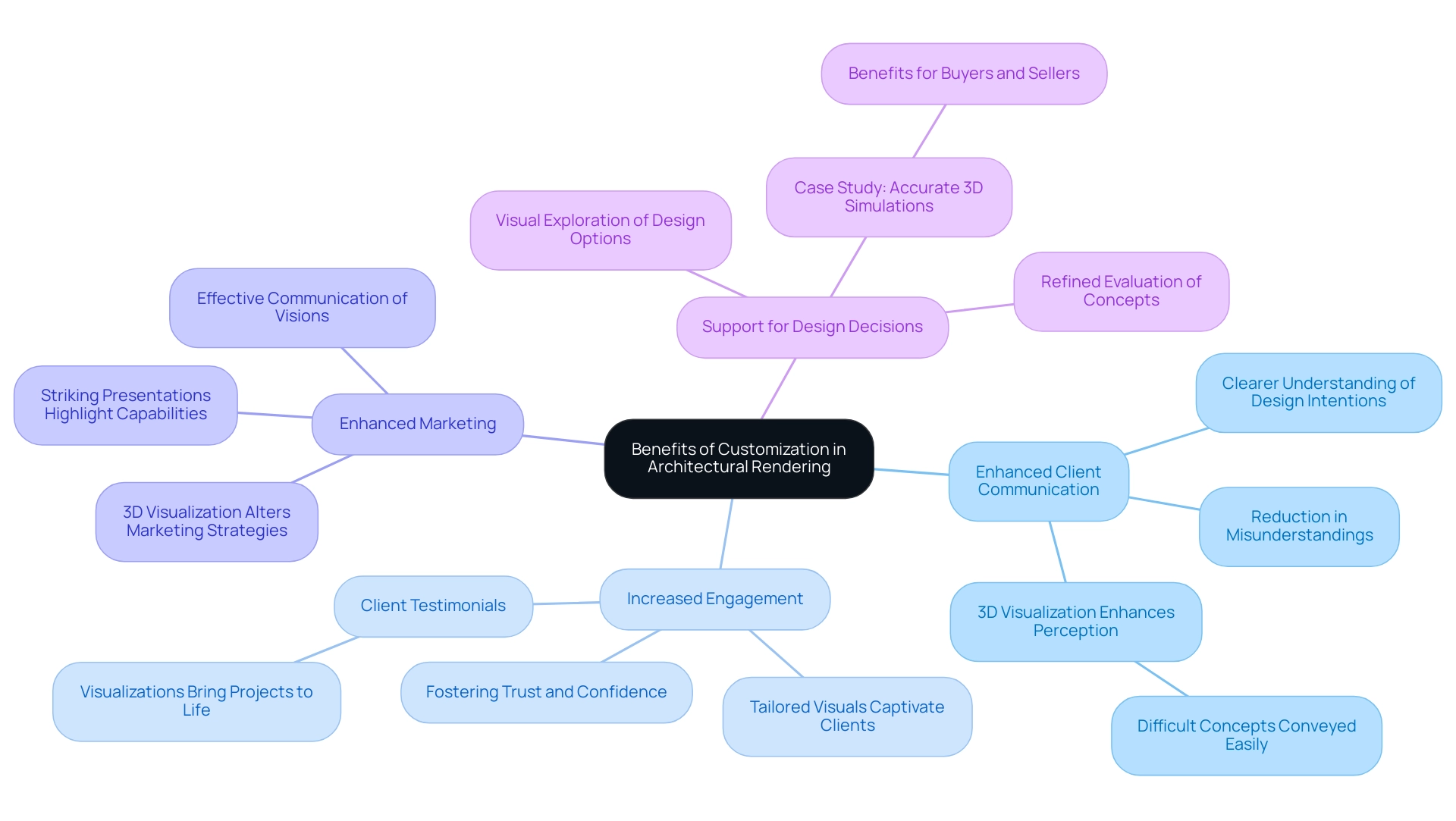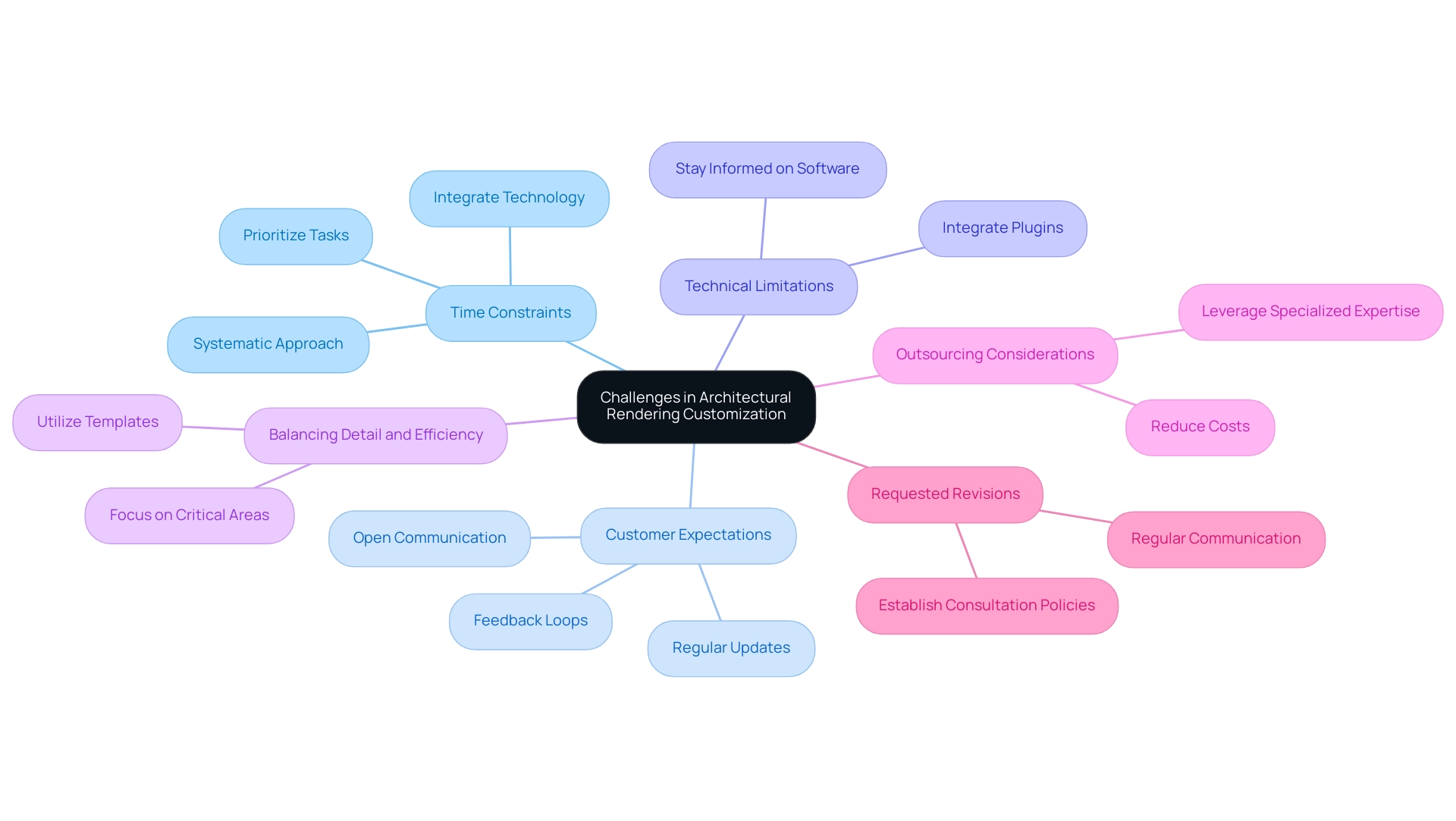Introduction
In the realm of architectural design, the significance of rendering cannot be overstated. It serves as a crucial conduit between abstract concepts and tangible outcomes, allowing stakeholders to visualize projects before they materialize. Architectural rendering encompasses a spectrum of techniques, from intricate 3D models to immersive visual narratives that enhance communication among architects, clients, and contractors.
As technology advances, the integration of artificial intelligence and sophisticated software is transforming the landscape of architectural visualization, enabling unprecedented levels of realism and customization. This article delves into the multifaceted world of architectural rendering, exploring its definition, importance, and the tools that empower architects to create compelling visuals that not only captivate clients but also drive project success.
Understanding Architectural Rendering: Definition and Importance
Design visualization involves the creation of two-dimensional and three-dimensional visual representations that express the characteristics of suggested design concepts. This process is critical in helping stakeholders visualize the final outcome prior to construction, thereby serving as a bridge between concept and reality. Effective architectural visualization not only serves as a strong marketing tool, highlighting the endeavor’s potential through realistic images, but also promotes clear communication among architects, customers, and contractors.
The role of pre-sales visualization is crucial, as it boosts project confidence and generates investment through compelling images that showcase functionality and aesthetics. This is particularly evident in interior design renderings, which can significantly impact satisfaction and marketing effectiveness by allowing individuals to envision their future spaces. Moreover, as technology advances, the incorporation of AI in creating lifelike CG humans is transforming visualizations, bridging the gap between realism and the uncanny valley.
The ability to utilize architectural rendering customization for these visualizations allows for tailored outcomes that capture specific design intents and client requirements, underscoring its essential role in the design workflow. In light of recent statistics, where 70% of architecture firms plan to enhance their technological investments, it is evident that the demand for advanced architectural visualization techniques is on the rise. Notably, 40% of firms achieving their goals plan to invest in management software, highlighting a focused approach to enhancing internal processes.
Furthermore, the global digital asset management (DAM) market was valued at $3.96 billion in 2023, as noted by Fortune Business Insights, and is projected to reach $16.18 billion by 2032. This growth indicates an increasing awareness among companies of the importance of integrating advanced visualization techniques to enhance client satisfaction and simplify management of tasks. The case study titled ‘Digital Asset Management (DAM) in AEC’ demonstrates how cloud-based collaboration tools are utilized by 62% of architecture firms, highlighting the need for better internal processes in marketing and execution.
Additionally, 3D exterior visuals play a crucial role in enhancing communication between homeowners and builders by effectively showcasing natural lighting, landscaping, and building materials, providing a comprehensive visualization of the project.
Expert Tips for Customizing Architectural Renderings
Know Your Audience: Understanding the specific preferences and expectations of your target audience is paramount in design rendering. Tailoring visuals through architectural rendering customization to resonate with clients not only enhances engagement but also effectively communicates your design intent. Research indicates that the psychological dimensions of design preferences correlate with brain activation, emphasizing that layouts should be audience-centric to evoke the desired emotional response. For example, the recent construction tender awarded for Snellerpoort B2—Huis in ‘t Veld to the Municipality of Woerden and its partners illustrates how audience understanding can drive successful outcomes.
Utilize Realistic Textures: The use of high-resolution textures significantly elevates the visual appeal of architectural renderings. Realistic representations of materials not only enhance aesthetics but also provide tactile sensations that clients can relate to. Architectural rendering customization is crucial for personalizing these textures to fit the specific design context, creating impactful visuals that resonate with viewer expectations and foster a deeper emotional connection. These textures, when meticulously chosen, contribute to the storytelling aspect of the design, making the work feel more tangible and inviting.
Lighting Matters: The lighting arrangement within visualizations plays a critical role in showcasing architectural features. Experimenting with different lighting scenarios can create diverse moods and highlight the intricacies of your designs. Natural light, specifically, enhances realism; thus, taking into account the time of day in your simulations can result in a more genuine representation of the work and amplify its emotional impact. Proper lighting not only illuminates the design but also shapes the narrative, guiding the viewer’s emotional journey through the space.
Including aspects from the surrounding environment in your visuals offers a sense of place and scale, enabling stakeholders to imagine the project in its intended setting. This contextualization not only enriches the narrative but also helps in establishing a connection between the design and its environment. The case study of Atelier Archiplein’s Lakeside Villa Update exemplifies this balance, successfully modernizing a 1960s villa while preserving its historical charm, showcasing the importance of context in design.
Iterate and Seek Feedback: The process of creating architectural renderings should involve multiple iterations and constructive feedback. Interacting with peers or customers during the development phase can lead to insights that refine and enhance the final visuals. Embracing iterative design fosters a culture of continuous improvement and ensures that the end product meets client expectations effectively. As Gordon aptly stated, > curves are in general felt to be more beautiful than straight lines <, a principle that can also be applied to the nuances of aesthetics. The newest trends in architectural rendering customization highlight the significance of understanding audience preferences and consistently enhancing visuals to communicate stories and showcase value propositions. Furthermore, design visualization is increasingly acknowledged as a transformative instrument for marketers, highlighting the importance of personalization and audience interaction in modern practices.
Essential Tools and Software for Architectural Rendering
To achieve exceptional quality in architectural renderings, architects should invest in both the right tools and the meticulous customization of their projects:
- Autodesk 3ds Max: Esteemed for its robust modeling and rendering capabilities, this software excels in producing intricate 3D models, making it a staple for professionals requiring precision in their designs.
- V-Ray: This advanced visualization engine integrates seamlessly with various modeling platforms, delivering photorealistic results through architectural rendering customization options, thus enabling architects to fine-tune every aspect of their visualizations and enhance the emotional impact of their work.
SketchUp: Celebrated for its intuitive interface, SketchUp is particularly effective for preliminary 3D modeling, allowing architects to swiftly develop concepts before transitioning to more complex software solutions.
Lumion: Known for its real-time visualization abilities, Lumion enables architects to produce stunning representations easily, making it a perfect option for compelling presentations that can engage stakeholders.
- Adobe Photoshop: Indispensable for post-processing, Photoshop enhances images by adjusting colors, adding effects, and refining intricate details, thus elevating the overall quality of the visual outputs and ensuring that every project feels real and lived-in.
- Octane Render: Introduced in 2010, Octane Render is a GPU-accelerated software known for its speed and photorealistic output, available on multiple platforms. It requires a powerful GPU for optimal performance, making it a significant option for contemporary architectural visualization.
- FStormRender: Priced at $25/month, FStormRender caters to both professionals and amateurs, achieving an overall rating of 4.0 in 2024. Its cost is justified by the quality of images it produces, making it a valuable investment for achieving high-quality visualizations.
As mentioned by Anton Giuroiu, a RIBA accredited architect, ‘Cinema 4D is renowned for its comprehensive abilities in 3D modeling, animation, and visual output, catering to a wide range of creative fields since 1990.’ This highlights the significance of choosing tools that not only exhibit technical skill but also enable architectural rendering customization to address the varied requirements of design practice, ultimately influencing the investment choices for distinct visual endeavors. Our enthusiasm for capturing intricate details guarantees that every element in the representations adds to a creation that feels genuine and ready for construction.
The Benefits of Customization in Architectural Rendering
The advantages of architectural rendering customization in architectural visualization significantly enhance the overall design process and client interaction.
Enhanced Client Communication: Tailored visuals facilitate a clearer understanding of design intentions, reducing the potential for misunderstandings and minimizing unnecessary revisions. This direct communication pathway is vital for maintaining momentum of the initiative. According to industry statistics, 3D visualization enhances perception, allowing design concepts that are difficult to convey through 2D drawings to be easily visualized with 3D models. Pre-sales renderings serve as a powerful testament to a project’s vision, empowering developers to attract interest and investment early in the process, ultimately generating crucial revenue for construction.
Increased Engagement: Renderings uniquely crafted to reflect a customer’s specific vision tend to captivate and impress, thereby fostering a sense of trust and confidence in the architect’s expertise. As seasoned 3D expert Sushmita Roy observes, the ability to connect with customers through tailored visuals is paramount. Client testimonials at J. Scott Smith Visual Designs reinforce this notion, illustrating that our focus on delivering exceptional results and building lasting partnerships significantly enhances the overall experience. One customer remarked, “The visualizations brought our project to life even before construction began, instilling confidence in our investors.”
Enhanced Marketing: Striking and distinctive presentations highlight a firm’s capabilities and serve as powerful marketing tools that attract potential clients. The influence of 3D visualization alters conventional marketing strategies by offering captivating visual stories. Recent news highlights how 3D rendering services can help property sellers effectively convey their visions to their target audience, further emphasizing the effectiveness of detailed interior renderings in showcasing functionality and aesthetics.
Support for Design Decisions: Customization empowers architects to explore various design options visually, aiding in the decision-making process. This capability allows for a more refined evaluation of design concepts, ultimately leading to more informed and strategic design outcomes. A notable case study illustrates how visualization companies create accurate 3D simulations and prototypes for real estate projects, effectively communicating project ambitions and benefiting both buyers and sellers.
The shift towards utilizing personalized architectural rendering customization is not merely a trend; it is a critical step in enhancing both customer satisfaction and engagement, driving a more effective and responsive architectural practice. The honest feedback from our clients not only serves as a testament to our work but also forms a cornerstone of our commitment to excellence and continuous growth.
Overcoming Challenges in Architectural Rendering Customization
Architectural rendering customization presents a range of challenges that require strategic management to ensure successful outcomes. Among these challenges are:
- Time Constraints: Customizing renderings can be an extensive process, often leading to delays. To mitigate this, it is crucial to develop a systematic approach that prioritizes tasks and integrates architectural rendering customization to streamline workflows, thereby enhancing overall efficiency.
This is especially significant as 70% of architecture firms are intending to invest more in technology, which can play a crucial role in optimizing visualization processes and potentially decreasing turnaround time based on complexity.
- Customer Expectations: Misaligned customer expectations can result in dissatisfaction and project setbacks. Maintaining open lines of communication is essential throughout the rendering process.
Regular updates and feedback loops help ensure that the customer’s vision is accurately captured, fostering a collaborative environment that enhances satisfaction. The growing diversity within architectural teams, as noted by the AIA, where women now account for over a quarter of the membership, can also enrich collaboration and understanding of varied client needs.
- Technical Limitations: Constraints imposed by software can impede the customization process.
Architects must stay informed about the latest software capabilities and consider integrating plugins or extensions that can significantly enhance functionality. This proactive method is essential, particularly as 28% of global architects indicate that their designs qualify as green, which frequently requires architectural rendering customization to meet sustainability standards.
- Balancing Detail and Efficiency: Achieving a balance between creating detailed representations and adhering to project timelines can be challenging.
Utilizing templates for common elements can save time while allowing architects to focus on critical areas that demand customization. By adopting this strategy, firms can better manage their resources and deliver high-quality results within tight deadlines.
- Outsourcing Considerations: Many firms choose to outsource 3D architectural visualization to leverage specialized expertise, reduce costs, and enhance efficiency.
By outsourcing, companies can concentrate on their core strengths while ensuring high-quality outputs that satisfy customer expectations.
- Requested Revisions: During the creation process, it is common for customers to ask for modifications. Establishing clear consultation policies regarding these revisions is essential to manage expectations and ensure timely delivery.
Regular communication about potential changes can help streamline this process and maintain client satisfaction.
These strategies not only address the urgent challenges of architectural rendering customization but also enable firms to respond effectively to the changing demands of the industry. Furthermore, insights from the case study on architecture firm investment strategies demonstrate that 70% of firms are actively seeking to leverage technology to overcome these challenges, while the use of 3D visualizations helps designers and developers communicate their ideas clearly, resolve design issues early, and streamline project workflows.
Emphasizing client collaboration and quality assurance throughout the final delivery process is essential for achieving refined architectural renderings that align with client expectations.
Conclusion
Architectural rendering stands as a pivotal element in the design and construction process, bridging the gap between concept and reality. Through various techniques, including advanced 3D modeling and immersive visual narratives, architects can effectively communicate their visions to clients and stakeholders, thereby enhancing project understanding and confidence. The integration of sophisticated software and artificial intelligence further elevates the quality and customization of these renderings, allowing for an unprecedented level of detail and realism that resonates with viewers.
Customization emerges as a key theme in architectural rendering, significantly enhancing client communication, engagement, and satisfaction. Tailored visuals not only facilitate clearer design intentions but also serve as powerful marketing tools that can attract investment and interest in projects. By understanding the audience and utilizing realistic textures and lighting, architects can create compelling narratives that reflect the unique characteristics of each design while fostering emotional connections with clients.
Despite the challenges inherent in customization, such as time constraints and client expectations, strategic management and the adoption of advanced technologies can streamline the rendering process. By balancing detail with efficiency and maintaining open lines of communication, architects can navigate these complexities and deliver high-quality visuals that meet client demands. Ultimately, the continued evolution of architectural rendering practices underscores its essential role in driving project success and enhancing the overall architectural workflow. As the industry embraces these advancements, the future of architectural rendering promises even greater innovation and impact.






0 Comments